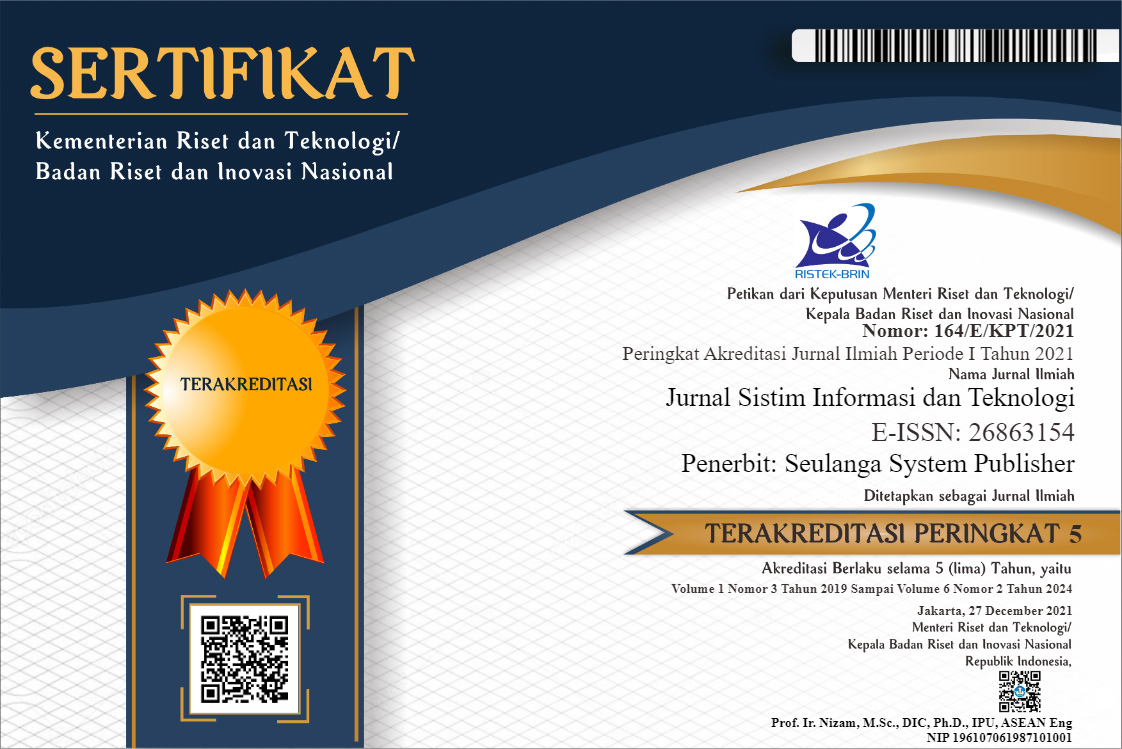Algoritma K-Means Clustering dalam Optimalisasi Komposisi Pakan Ternak Ayam Petelur
DOI:
https://doi.org/10.37034/jsisfotek.v5i2.168Keywords:
Data Mining, K-Means, Clustering, Laying Chicken Feed, Composition OptimizationAbstract
In Indonesia, the laying hens business sector experiences many obstacles, farmers often face instability between the price of chicken eggs and the price of feed which tends to always increase. The income received by farmers is not proportional to the cost of feed incurred. The production cost of laying hens can be reduced if there is an increase in feed efficiency. Maintenance of laying hens lies in the provision of feed, water, physical conditions and the state of the cage. Feed is the main source of energy for laying hens. The problem of feed in laying hens must meet the quality and quantity of the feed itself so that the effect is very real and clear on egg production. Feed nutrition must also meet the needs of laying hens. Feeding laying hens without paying attention to the quality of the feed can result in the growth and productivity of chickens being not optimal. Combining feed is an effort that can be made to produce a quality feed composition. This research was conducted to compile the composition of laying hens' feed using the K-Means Clustering algorithm. The K-Means Clustering method is an algorithm used by researchers to group or cluster data on laying hens feed into several clusters by using the nutritional content of each feed as an attribute. In this study, the data analyzed was data on the nutritional content of laying hens feed consisting of attributes such as protein, fat, crude fiber, calcium and phosphorus. This study will produce 3 clusters of feed types consisting of highly optimal clusters, optimal clusters and less than optimal clusters. This research is expected to be used as a recommendation by laying hens in compiling the composition of laying hens to maintain the quality of the eggs produced.
References
Putri, A. F. L., & Bintari, S. H. (2021). Pengaruh Pemberian Pakan Dengan Penambahan Overripe Tempeh Terhadap Konsumsi Pakan, Pertambahan Bobot Badan Dan Konversi Pakan Pada Ayam Petelur. Life Science, 10(1), 33-41. DOI https://doi.org/10.15294/lifesci.v10i1.47168
Palupi, R., Lubis, F. N. L., Sandi, S., Arjuna, A. R., Satori, C., & Nurrahmadani, M. (2022). Pengaruh suplementasi kalsium butirat dalam ransum terhadap kecernaan nutrien, performa produksi dan kualitas telur ayam umur 75 minggu. Livestock and Animal Research, 20(1), 59-68. DOI: https://doi.org/10.20961/lar.v20i1.55949
Utiah, W., Paputungan, U., & Tangkau, L. M. S. (2021). Analisis Faktor Konsentrat Pakan Komersil Berbeda Terhadap Sifat-Sifat Produksi Ayam Ras Petelur. ZOOTEC, 41(2), 525-533. DOI: https://doi.org/10.35792/zot.41.2.2021.36928
Fadhlurrohman, R., Suarman, D. F., Umar, M. Z., & Atifah, Y. (2022, May). Pengaruh Faktor Lingkungan Terhadap Reproduksi Ayam Ras Petelur. In Prosiding Seminar Nasional Biologi (Vol. 1, No. 2, pp. 709-714). DOI: https://doi.org/10.24036/prosemnasbio/vol1/181
Nuraliza, H., Pratiwi, O. N., & Hamami, F. (2022). Analisis Sentimen IMBd Film Review Dataset Menggunakan Support Vector Machine (SVM) dan Seleksi Feature Importance. Jurnal Mirai Management, 7(1), 1-17. DOI: https://doi.org/10.37531/mirai.v7i1.2222
Putri, H., Purnamasari, A. I., Dikananda, A. R., Nurdiawan, O., & Anwar, S. (2021). Penerima Manfaat Bantuan Non Tunai Kartu Keluarga Sejahtera Menggunakan Metode NAÏVE BAYES dan KNN. Building of Informatics, Technology and Science (BITS), 3(3), 331-337. DOI: https://doi.org/10.47065/bits.v3i3.1093
Hasanah, M. A., Soim, S., & Handayani, A. S. (2021). Implementasi CRISP-DM Model Menggunakan Metode Decision Tree dengan Algoritma CART untuk Prediksi Curah Hujan Berpotensi Banjir. Journal of Applied Informatics and Computing, 5(2), 103-108. DOI: https://doi.org/10.30871/jaic.v5i2.3200
Putri, S. U., Irawan, E., & Rizky, F. (2021). Implementasi Data Mining Untuk Prediksi Penyakit Diabetes Dengan Algoritma C4. 5. Kesatria: Jurnal Penerapan Sistem Informasi (Komputer dan Manajemen), 2(1), 39-46. DOI: https://doi.org/10.30645/kesatria.v2i1.56
Muningsih, E., Maryani, I., & Handayani, V. R. (2021). Penerapan Metode K-Means dan Optimasi Jumlah Cluster dengan Index Davies Bouldin untuk Clustering Propinsi Berdasarkan Potensi Desa. EVOLUSI: Jurnal Sains dan Manajemen, 9(1). DOI: https://doi.org/10.31294/evolusi.v9i1.10428
Adiputra, I. N. M. (2022). Clustering Penyakit Dbd Pada Rumah Sakit Dharma Kerti Menggunakan Algoritma K-Means. INSERT: Information System and Emerging Technology Journal, 2(2), 99-105. DOI: https://doi.org/10.23887/insert.v2i2.41673
Nabila, Z., Isnain, A. R., Permata, P., & Abidin, Z. (2021). Analisis Data Mining Untuk Clustering Kasus Covid-19 Di Provinsi Lampung Dengan Algoritma K-Means. Jurnal Teknologi Dan Sistem Informasi, 2(2), 100-108. DOI: https://doi.org/10.33365/jtsi.v2i2.868
Jananto, A. (2022). Penerapan Algoritma K-Means Clustering Untuk Perencanaan Kebutuhan Obat Di Klinik Citra Medika. Progresif: Jurnal Ilmiah Komputer, 18(1), 69-76. DOI : https://doi.org/10.35889/progresif.v18i1.769
Abdullah, D., Susilo, S., Ahmar, A. S., Rusli, R., & Hidayat, R. (2022). The application of K-means clustering for province clustering in Indonesia of the risk of the COVID-19 pandemic based on COVID-19 data. Quality & Quantity, 56(3), 1283-1291. DOI: https://doi.org/10.1007/s11135-021-01176-w
Kurniawan, R. A., Hasibuan, M. S., Piramida, P., & Ramadhan, R. S. (2022). Penerapan Algoritma K-Means Untuk Clustering Tempat Makan Di Batubara. Journal of Computer Science and Informatics Engineering (CoSIE), 10-18. DOI: https://doi.org/10.55537/cosie.v1i1.27
Gesicho, M. B., Were, M. C., & Babic, A. (2021). Evaluating performance of health care facilities at meeting HIV-indicator reporting requirements in Kenya: an application of K-means clustering algorithm. BMC Medical Informatics and Decision Making, 21(1), 1-18. DOI: https://doi.org/10.1186/s12911-020-01367-9
Hutagalung, J. (2022). Pemetaan Siswa Kelas Unggulan Menggunakan Algoritma K-Means Clustering. JATISI (Jurnal Teknik Informatika dan Sistem Informasi), 9(1), 606-620. DOI: https://doi.org/10.35957/jatisi.v9i1.1516
Marpaung, P., & Siahaan, R. F. (2021). Penerapan Algoritma K-Means Clustering Untuk Pemetaan Kepadatan Penduduk Berdasarkan Jumlah Penduduk Kota Medan. J-SAKTI (Jurnal Sains Komputer dan Informatika), 5(1), 503-521. DOI: http://dx.doi.org/10.30645/j-sakti.v5i1.343
Sulistiyawati, A., & Supriyanto, E. (2021). Implementasi Algoritma K-means Clustring dalam Penetuan Siswa Kelas Unggulan. Jurnal Tekno Kompak, 15(2), 25-36. DOI: https://doi.org/10.33365/jtk.v15i2.1162
Dwitri, N., Tampubolon, J. A., Prayoga, S., Zer, F. I. R., & Hartama, D. (2020). Penerapan algoritma K-Means dalam menentukan tingkat penyebaran pandemi COVID-19 di Indonesia. (JurTI) Jurnal Teknologi Informasi, 4(1), 128-132. DOI: https://doi.org/10.36294/jurti.v4i1.1266
Hidayati, R., Zubair, A., Pratama, A. H., & Indana, L. (2021). Analisis Silhouette Coefficient pada 6 Perhitungan Jarak K-Means Clustering. Techno. Com, 20(2), 186-197. DOI: https://doi.org/10.33633/tc.v20i2.4556
Downloads
Published
How to Cite
Issue
Section
License
Copyright (c) 2023 Jurnal Sistim Informasi dan Teknologi

This work is licensed under a Creative Commons Attribution 4.0 International License.









